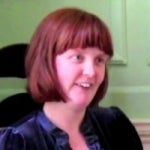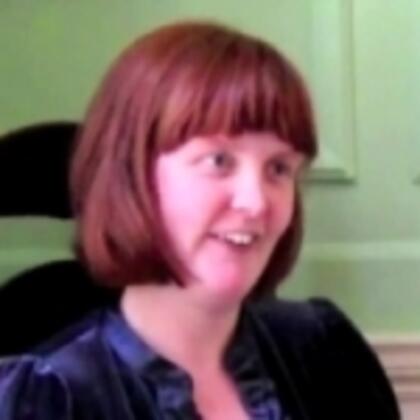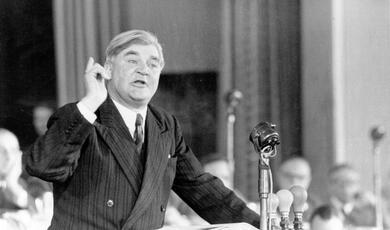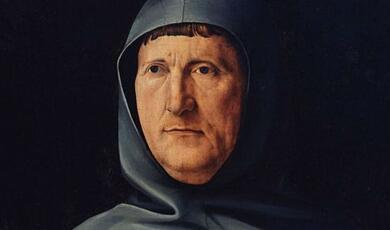18 June 2014
Dr Johnson's House:
Biography and Display
Morwenna Rae
Good afternoon. I am delighted to be here at Barnard’s Inn to introduce you to Dr Johnson’s House. I will be talking about how the House tells Johnson’s story through the collections and building at 17 Gough Square and whether we can really describe Dr Johnson’s House as a museum.
Out of interest, has anyone visited Dr Johnson’s House? Who has read any Johnson? Who has read Boswell’s Life of Johnson? Who has watched the Blackadder episode? Usually, Blackadder wins.
I have recently returned from a research trip to the USA, where I visited over twenty writers’ house museums, meeting with their staff to discuss how they approach education and the presentation of the houses and their former occupants to the public.
Whilst on the trip, I found that there were commonalities in the presentation of these houses. Most, understandably, focused on the domestic life of the writer; period rooms were set up as if the writer had just popped out for a few minutes. Where the writer’s own furniture was no longer extant (which was the case in most houses), reproductions or antiques were used. The majority of rooms were entirely or partially roped off and were only available to visit on a guided tour. Every single one had the writer’s desk displayed somewhere. Most of these desks were staged with facsimiles of manuscripts, a pen and an inkwell.
I was quite struck with the difference with Dr Johnson’s House. We do not have a writing desk – Johnson was not terribly careful of his furniture and any desk that he may have used has not found its way back to 17 Gough Square. We do not use replicas. We allow visitors to wander freely around the house and sit at the tables, where they can read or listen to information and generally soak up the atmosphere. It is really rather unusual. However, our visitor book shows that people enjoy the freedom, the peace and the feeling of ‘going back in time’. Of course, some would prefer fully furnished period rooms, but there are surprisingly few who hanker after a replica bedroom in lieu of our more ‘quirky approach to curating’ - a comment from our most recent visitor survey.
So, why do we do things so differently? It is ultimately due to the strong views of the person who opened the house to the public in the early twentieth century. 17 Gough Square has had a varied history. It was built in c. 1700 and Johnson rented it from c.1748 - 1759. After he left it had various uses. For part of the nineteenth century, it was used as a boarding house and hotel. By the turn of the twentieth century it was a printer’s workshop and in 1910 was being advertised as warehouse space/for sale. At this time, it was in a state of advanced decay, but had always been known as the house in which Johnson had written his famous Dictionary of the English Language. Cecil Harmsworth, a Liberal MP who often came to the area, felt that it would be a pity if the house was lost, and purchased it accordingly, arranging for extensive repairs and restoration.
The majority of the structure and interior fittings had survived the years of benign neglect, so most of the original panelling, around half of the floorboards and some other eighteenth century features are still in situ. Harmsworth declared that nothing old should be removed and nothing new brought in, unless absolutely necessary – entirely out of step with many in the burgeoning historic house preservation movement at that time, who were restoring houses to their ‘original’ appearance. Gough Square has been left with more layers of its history on show.
Dr Johnson’s House was open to the public by 1914 and run by Harmsworth, with a resident custodian managing the day-to-day operations. In 1929, he formed a Trust to take over the running of the House and in 1944, he formally laid down his principles for collecting and display. These have been the guidelines ever since.
“…The decoration and furnishing of the House presented difficulties. How was the House decorated in Dr Johnson’s time?... Nobody knew… A resort to durability, simplicity, and CHEERFULNESS was plainly indicated. This was the motive adapted… No Johnson furniture, such as it may have been, was known to exist otherwise than at the birthplace at Lichfield and at Pembroke College. It was decided that the simplest rush-bottomed farmhouse chairs should be secured, with gate-leg tables of the “Cromwellian” type. These would be old enough and simple enough for the purpose. Of later, and more elegant examples, it was considered that they would have been beyond Dr Johnson’s reach….
… Some pictures must be displayed on the walls, but never so numerously as to obscure the architectural features of the House. Here, there could be no doubt that, with such few paintings and colour prints as might be forthcoming, mezzotints could be the only choice – with a stiff resistance to steel engraving, framed photographs or other odds and ends in frames…
…From the first, the intention was that the House should never come to be regarded as a Museum or as an emporium of irrelevant 18th-century bric-a-brac. It was to be a Johnson House open wide to his admirers and available for occasional tea parties and more robust festivities. A house without fun and laughter and good talk could never be regarded, it was felt, as a suitable memorial to the man who shook laughter out of you whether you willed it or not and who lived to stretch his legs under the table and “have his talk out”.
It is a clear statement of intent. Dr Johnson’s House was not and should never become a museum.
As Johnson was not wealthy, or prone to looking after things, we do not have lots of items that he owned on display. Harmsworth expressly forbade acquiring ‘bric-a-brac’ to populate the rooms. So, how do you tell the story of a man in a house with rooms displaying so few objects? Everything on display has a connection to Johnson and an anecdote or two attached. Many have little intrinsic value or interest, but the act as illustrations to the biographical story told in the house. Despite the obvious differences with museums, our visitors still describe the House as a museum. We are members of the Association of Independent Museums. We are an Accredited Museum. Yet simultaneously, as Harmsworth clearly stated, we are not a museum.
In the USA, other museum colleagues often referred to a 2001 study by the American Alliance of Museums, which found that museums and libraries were deemed the most trustworthy source of information. 87% of respondents felt they could entirely trust a museum, compared with 61% having faith in a book on the subject. This statistic baffled me – what did the respondents believe museums use for research? However, if Dr Johnson’s House is considered as in the same category as museums and libraries, it is potentially more trusted by visitors than the detailed biographies that we sell in the shop. This creates a challenge that is about more than simply fact-checking and writing clear captions.
Is our interpretation of Johnson’s life balanced? Can we convey enough information in a single visit to get a reasonable overview of the subject without overwhelming our audience?
I will give you part of the tour. Let me invite you into the Parlour.
This portrait after John Opie is one of the more flattering images of Samuel Johnson. In it, he appears serene and tidy. In reality, neither of these things was true. His wig was often too small for his head and, being very short-sighted, he would hold candles close to his face while reading and set fire to it, leaving it singed down to the weave. His brown suit was often stained and frayed. His friends commented on his air of shabbiness.
Johnson was strong and about six feet tall. He once knocked down a bookseller with one of his books. He was also rather large and enjoyed his food. Boswell noted that, when eating, ‘the veins of his forehead swelled, and generally a strong perspiration was visible.’ His health problems were also apparent to those around him. As an infant, he contracted scrofula (tuberculosis of the lymph glands) which ultimately left him short-sighted, hard of hearing and scarred on his lower face and neck.
Despite the bad start, he was an independent child and his extraordinary intelligence was soon noticed. He went to his local grammar school in Lichfield, where he would do his friends’ homework and in return they would carry him to school on their backs. He read voraciously through the stock in the family bookshop, but was of little help to his father when it came to selling it. The family’s fortunes declined, but a small legacy from an aunt paid for the young Samuel to attend Oxford University for one year. It was hoped that his cleverness would bring him a scholarship for the remaining time, but this was not forthcoming. He left Oxford without a degree and struggled through his twenties in the Midlands until moving to London to try his hand as a writer.
The mental health problems that plagued him throughout his life became evident during these years. He suffered from recurrent ‘melancholy’ and had at least one nervous breakdown during his lifetime. He feared that he would run mad and therefore surrounded himself with others. He also had physical ticks. James Boswell described Johnson’s ‘anxious care’ to cross the threshold of a door on the correct foot and that when talking,
“…he commonly held his head to one side towards his right shoulder, and shook it in a tremulous manner, moving his body backwards and forwards, and rubbing his left know in the same direction, with the palm of his hand”.
Johnson’s mannerisms were eccentric, his table manners reputedly terrible and he could be somewhat aggressive in argument. After one animated discussion, he was described as having ‘tossed and gored several persons.’ However, despite all of this, Johnson was usually wonderful company, funny, witty, intelligent and, underneath the crusty exterior, exceptionally generous and humane. He would put pennies in the hands of sleeping street children so they could buy breakfast when they woke, despite his constant and chronic shortage of funds.
His generosity was most obvious within his own household. This portrait reputedly shows Francis Barber, who arrived in Johnson’s household in 1752 aged ten years. He moved into Gough Square shortly after the death of Johnson’s wife, when Johnson was grieving, depressed, short of money and had missed the deadline for his Dictionary. Barber was a slave, having come from a Jamaican plantation belonging to the Bathurst family, who were good friends of Johnson. Barber was a cheery, intelligent boy, and the Bathursts thought that he would be useful to Johnson during this difficult time.
Johnson hated slavery, did not want a servant anyway, and promptly sent the boy to boarding school for a decent education. Over the years, he spent hundreds of pounds educating Barber, who was freed upon the death of Colonel Bathurst a few years later. Barber spent most of the next 32 years as Johnson’s manservant and companion, was at his bedside when he died and was the main beneficiary in the childless Johnson’s will. Johnson’s kindly treatment of ‘Frank’ raised some eyebrows amongst Johnson’s friends, particularly as he did not require Barber to undertake much actual work. Johnson also took in a blind poet, an unqualified physician, a penniless widow and her daughter, and a girl that he found half-dead in the street. They all hated each other and his household was argumentative and chaotic, but Johnson would not be persuaded to turn them out. Far from an ivory tower, Johnson wrote, as he described in the Preface to his Dictionary,
“…with little assistance of the learned, and without any patronage of the great; not in the soft obscurities of retirement, or under the shelter of academick bowers, but amidst inconvenience and distraction, in sickness and in sorrow”.
There are a few misconceptions about Johnson’s Dictionary. It is often described as the ‘first dictionary’. This is nonsense; word-lists, glossaries and dictionaries have been around for centuries, if not millenia. The French Academy had completed a recognisably modern monolingual French Dictionary in the seventeenth century.
Was it the first English dictionary? No. That accolade is generally given to Robert Cawdrey’s 1604, A Table Alphabeticall. During the eighteenth century, there were a number of other dictionaries, although the most popular, by Nathan Bailey, defined dog as ‘an animal well-known’ and blue as ‘a colour’. The field of English lexicography was ripe for improvement.
Did Johnson decide to write a dictionary as a leisurely academic or idealistic exercise to fill this gap? Absolutely not. He was chronically short of money and that would have been madness. In fact, it was a group of booksellers, headed up by Robert Dodsley, who paid 1,500 guineas in 1746 and commissioned Johnson to complete the work in three years.
One of Johnson’s friends, Dr Adams, felt that three years was a little optimistic and reminded Johnson that “the French Academy, which consists of forty members, took forty years to compile their Dictionary.” Johnson characteristically replied: “Sir, thus it is. This is the proportion. Let me see; forty times forty is sixteen hundred. As three to sixteen hundred, so is the proportion of an Englishman to a Frenchman.”
As it turned out, the project did overrun as Johnson gradually found his way to a methodology and style. Initially, he planned that his dictionary would standardise spelling and pronunciation; trace the etymology of each word; define all the different senses of meaning of a word; include quotations from the ‘best authors’ to illustrate usage of each word; eliminate improper usage– for example, he was concerned about the ‘Frenchification’ of English; improve the orderliness of the language – he likened it to a weedy overgrown garden; and finally, he wanted his dictionary to fix the language to prevent any change. When he began the work, Johnson saw language change as decay and erosion.
He set about finding illustrative quotations, marking pages in hundreds of books. Each quotation was then copied onto a slip of paper by an amanuensis and filed alphabetically. The files were his word lists and as the project progressed, the slips would be stuck into notebooks with gaps left in between. Johnson planned to write his definitions in these gaps.
It went smoothly for three years, until he started to paste in the quotations. The gaps were too small. The manuscript became physically messy and stylistically confused. It was impossible for the printer to follow, so the first portion that Johnson sent across was promptly sent back to Gough Square and he had to start again.
It took him a total of nine years to finish the work and the end product was not the prescriptive, orderly work that he had originally envisaged. In the Preface, Johnson wrote that ‘only a fool thinks that they can embalm a language’. He had given up the idea of fixing a language and abandoned tidying up the messiness of English. The published Dictionary was far more descriptive than originally intended, although Johnson had not abandoned his opinions. His voice is very present in the definitions. Definition number eight for the word dull is ‘not exhilarating; as in to write dictionaries is dull work.’ Ruse is defined as ‘cunning; artifice; little stratagem; trick; wile; fraud; deceit. A French word neither elegant nor necessary.’ He describes words as vulgar, cant, should not be used, or elegant and should be used. The majority of his definitions are clear and sensible, but there are a few famous exceptions:
OATS n.s A grain, which in England is generally given to horses, but in Scotland supports the people.
STOCKJOBBER n. s. A low wretch who get money by buying and selling shares in the funds.
The Dictionary was published in 1755 in two folio volumes, priced at £4,10s. There are 42,773 definitions and over 114,000 illustrative quotations. Over the years, with various abridgements and editions, Johnson’s became the main dictionary used in the English speaking world and remained so for many decades, influencing the next generations of lexicography.
The Dictionary made him famous, but it did not make him rich and he had to leave Gough Square for cheaper lodgings in 1759. It was not until the 1760s that a royal pension made him more financially secure, he was granted his honorary doctorate, as well as meeting Boswell, the Thrales and other characters that populate the many subsequent biographies. Although best known for his Dictionary, Johnson was a prolific writer in many genres and for many years after 1755. His last major work, the seminal Lives of the Poets, was completed in 1781. He died in 1784 at his home in Bolt Court, a stone’s throw from Gough Square, and was buried in Poet’s Corner.
That was a condensed version of the tour. Each of those pictures hang in the House and we use them to illustrate the biographical narrative. The Dictionary is in the final room, the Garret in which it was written. This gives us the opportunity to build up a solid context before we introduce it – and it ensures people are very keen to find out about this book that we keep mentioning. As the narrative is structured around the objects on display, we try to display items in a way that make the narrative as coherent as possible. Our approach is anecdotal – we focus on the stories the object can tell about Johnson, not the object itself.
But, how do we choose which stories to tell? Each object could have many stories. For example, we have some interesting pieces relating to the actor and theatre manager, David Garrick, including prints, furniture and his walking cane. A Shakespeare-related print could be used to discuss eighteenth century theatrical staging and relate it to Johnson’s own play, Irene, staged by Garrick and acted by Mrs Pritchard, both shown here performing Macbeth.
The prints could also be used to discuss the performance and content of Shakespeare’s plays in the eighteenth century. This links nicely to Garrick’s acting career – Richard III was his breakthrough role – and to Johnson’s important edition of Shakespeare’s plays.
Mrs Pritchard and the portrait of Sarah Siddons could prompt a discussion on female actors. Alternatively, the Sarah Siddons portrait was painted in the early twentieth century by William Powell Frith and is an example of the narrative paintings that were popular in the nineteenth and twentieth centuries, this one based on an anecdote from Boswell’s Life. We could also discuss the eighteenth century print market, Georgian furniture or fashion, or even the ivory trade in the eighteenth century. The potential stories are endless.
But, this is Dr Johnson’s House, so everything is viewed through the lens of Dr Johnson. The initial story that we tell about the Garrick objects is that of Garrick’s friendship with Johnson. He was a pupil at Johnson’s unsuccessful school, travelled with Johnson to London to seek work and the two remained friends until Garrick’s death. We repeat Boswell’s charming anecdote of how the two men came to London, sharing a horse, with only a few pennies in their pockets.
Why have we chosen to tell this story? It moves the biographical narrative forward by describing how Johnson failed in teaching, then moved to London and became a writer. It introduces Garrick, who is not known to many of our visitors. It is also an entertaining story.
On the other hand, we would go into more depth about Garrick’s career and discuss Johnson’s views on Shakespeare for a student of eighteenth century theatre.
Essentially, we are trying to create a coherent biography. This is easier in a guided tour or audio tour, but, at the core of all of our interpretation, we are constructing a biography, just as an author does.
However, we face constraints in our narrative that most writers can avoid. We base the narrative on our collection. However, as this depends on the availability of items and the generosity of donors, it is not entirely well-balanced. For example, Johnson was married for seventeen years to Elizabeth (Tetty) Porter. But we do not have anything to represent her. If our main method of constructing a narrative is around objects, then where does that leave Mrs Johnson?
What we do have is a photograph of the only known portrait of Mrs Johnson. Thus, we had an interesting curatorial decision to take. Do we choose only to display items that are generally regarded as ‘museum objects’? In which case, we cannot display the photograph. Cecil Harmsworth’s instruction about avoiding ‘odds and ends in frames’ is also discouraging. However, this approach would marginalise Tetty’s role in Johnson’s life, despite seventeen years of marriage and having actually known the House. Others who are better known, but have only a minor connection to Johnson, would be better represented in our displays than his own wife.
So, is telling the story of the Johnson’s marriage more important than whether the object itself is worthy? Should we put a photograph of the real thing on display for the sake of a more balanced biography?
In the end we hung it discreetly in a corner. We prioritised giving a balanced view of Johnson’s life over the intrinsic interest and value of an object. Admittedly, it is far from ideal and pains me a little when I look at it, but I am working on getting a better quality reproduction and I am pleased that Mrs Johnson has a spot in her old house.
On the other hand, we have a superfluity of wonderful objects relating to Johnson’s friend and fellow writer, Elizabeth Carter. Visitors can see her bureau, books, manuscripts, table, chair and portrait. She was a good friend and an extraordinary character, but was she as important to Johnson as his wife? Or Boswell? At any rate, she features strongly in our interpretation as these objects are intrinsically interesting as eighteenth century pieces, were owned by a renowned scholar and have a Johnson connection. I am also reluctant to hide things away in storage when they can be out; but does this lead to an over-emphasis of Carter?
Probably, it does. But, on the other hand, it gives us an opening to discuss other aspects of Johnson. We use Carter to look at Johnson’s views on women – is it possible to square his view on women preachers (‘like a dog walking on its hind legs’) with his view that girls ought to receive an equal education to boys and strong admiration for Carter (‘the best translator of Greek in Europe’)? We digress from Carter to discuss a wider topic.
All biographers have to work with imbalanced sources. Boswell only knew Johnson for his last twenty years and had to scratch around Johnson’s remaining Lichfield friends for material about his childhood. So Dr Johnson’s House works around an existing imbalance that is exacerbated by gaps or excesses in our collection.
The other major constriction we face does not trouble biographers of the written word and that is the practicalities of display.
This portrait of Edward Cave is, quite honestly, hung in the wrong room. Cave was editor of the Gentleman’s Magazine and Johnson’s first employer in London. He should be hung in the library, near editions of Johnson’s work he published, or near Garrick and other friends from the 1740s. However, he is located in a room that is themed around Johnson’s life in the 1760s and 70s and his relationships with the Thrales, Boswell and the Club. Cave is not part of this story (he was long dead) but this is the only piece of wall panel in the house big enough to fit him. Thus, he rarely gets mentioned in tours and is given a passing reference in written information. If biographies are chronological or thematic, then Edward Cave is in the wrong chapter.
We finish our tour with the Dictionary section. A facsimile is available to leaf through in the Garret. According to the visitor book and surveys, this is visitors’ favourite thing in the house. Believe it or not, sometimes school children and teenagers have to be dragged away at the end of a workshop. Unlikely as it seems, what visitors of all ages tell us, is that sitting in a semi-furnished, minimally decorated, unheated garret and reading an obsolete dictionary has been a highly enjoyable and interesting way to spend their time. They might describe it as a museum in the visitor book, but this is not a typical museum experience.
So is Dr Johnson’s House a museum? This is not a straightforward question. It is definitely a historic house, but visitors seem to prefer to use ‘museum’. Trustees, staff and volunteers all call it ‘The House’; yet we are still part of the museum sector. We display objects, although we interpret them though Samuel Johnson rather than on their own terms. I met an academic who was researching literary houses and she felt that they could be described as biographies. I quite like the idea of the House being a physical biography, but it is not as simple as an alternative book.
In conclusion, Dr Johnson’s House does not quite fit into any clear pigeon hole, although the visitor who described it as quirky was definitely onto something. There are elements of museum, historic home, biography and even educational institution. In the end, not quite fitting in to a single category seems very appropriate for a site dedicated to such a contradictory and complicated character, especially as the original founder was so keen that the House reflected Johnson’s personality.
I do hope you can visit to ponder these questions and find out more about the man himself. As luck would have it, we are open until 8pm tonight and I highly recommend an evening visit.
Thank you for coming.
© Morwenna Rae, 2014


 Login
Login







